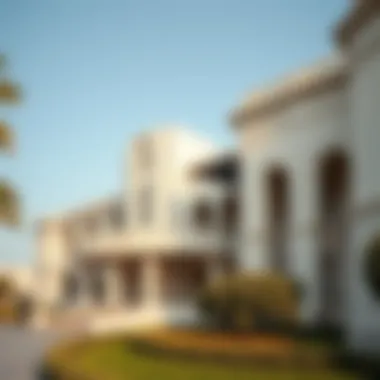The Cost of Excellence: UAE's Priciest School


Intro
In the vibrant educational landscape of the UAE, a handful of institutions stand tall above the rest, showcasing not just high academic standards but also opulent facilities and unique educational offerings. Among these is the prestigious school that commands the highest tuition fees in the region. Understanding what sets this institution apart is crucial for families considering enrollment, as well as for investors and real estate professionals who seek to grasp the implications of such elite education on property values and community development.
The high cost of tuition is often reflective of the facilities, faculty qualifications, and the overall experience that a school provides. For potential enrollees and their parents, it’s more than just an investment in education; it’s a gateway to a lifestyle filled with opportunities. As we delve into the economics of education in this part of the world, it's essential to consider how the price of admission to such a prestigious school impacts families, communities, and even the property market. It leads us into an exploration of market trends and insights, setting the stage for a deeper understanding of the educational elite.
Prelims to Education in the UAE
The education system in the United Arab Emirates is a tale of rapid transformation and diversification. Over the years, the UAE has evolved from a region with limited educational resources to one that boasts a highly competitive landscape, attracting both local and international students. Understanding the education sector is crucial for several reasons. First, it reflects the country’s commitment to its vision of building a knowledge-based economy. Secondly, it highlights the expectations parents have regarding educational quality, leading to the establishment of elite institutions with premium curriculums, such as the most expensive schools that we will explore.
Growth of the Education Sector
The education sector in the UAE has seen significant investment and growth, particularly in response to the diverse demographic landscape that includes a large expatriate community. Investment from both the government and private sectors has led to a boom in educational alternatives, ranging from public schools following the national curriculum to private schools offering various global curriculums, including British, American, and the International Baccalaureate.
The increase in the number of international schools and their varied offerings has contributed to making the UAE a hub for educational excellence in the region. As families flock to the UAE for professional opportunities, the demand for high-quality education has surged.
This growth is not just about focusing on academics; schools are also emphasizing character development, ethical education, and the importance of leadership skills. In particular, parents are often on the lookout for schools that provide holistic education experiences, which adds to the allure of expensive institutions that promise a premium experience.
Cultural Influences on Education
Cultural factors play a significant role in shaping the educational landscape in the UAE. The blend of traditional Arabic values and modern global influences results in a curriculum that is both innovative and respectful of local heritage. The UAE’s Vision 2021, which aims to enhance education quality, reflects the nation’s understanding of the importance of cultural context in learning.
Furthermore, the emphasis on bilingual education is a testament to how culture influences learning. Many schools encourage fluency in both Arabic and English, preparing students for an increasingly globalized world while fostering a connection to their roots.
It’s also essential to recognize the role of cultural events and initiatives that promote educational excellence amongst students. Competitions, educational fairs, and inter-school festivals enhance not just academic skills but also build a sense of community and collaboration among students.
In summary, the education sector in the UAE is not just growing—it is evolving. By understanding these cultural and structural dynamics, we build a clearer picture of what to expect from the most expensive schools in the region.
Defining the Most Expensive School
Understanding what qualifies as the most expensive school in the UAE is critical for parents, investors, and anyone interested in the educational landscape of the region. It’s not merely about the hefty price tags seen on tuition invoices, but rather the unique conditions and features that contribute to these costs. This section lays the groundwork for comprehending how schools can demand premium fees and what this signifies in terms of education quality, exclusivity, and overall value for students and their families.
Tuition Fees Explained
Tuition fees are, without a doubt, one of the most straightforward ways to assess a school’s expense. For families considering enrollment, knowing the specific figures involved can be a significant driver of their decisions. Schools like the British School Al Khaleej International or the American School of Dubai ask for fees that can range from 70,000 AED to upwards of 100,000 AED per year. Such costs can make heads spin. However, it's essential to peel back the layers to understand this financial commitment better.
For instance, tuition isn’t just a number on a paper; it often includes a raft of additional services. These might encompass extracurricular activities, academic resources, student wellbeing programs, and even transportation services. Furthermore, elite institutions frequently offer personalized learning experiences, which can reflect as much in the fee structures as in the statistical outcomes of their overtly successful graduates.
"Education in the UAE can feel like a rollercoaster, with high costs that don’t always correlate with superior outcomes. Yet, discerning parents remain interested in the subtleties of what they are investing in."
With tuition fees often gouging the wallets of families, understanding how these investments break down can provide clarity on their real worth. Parents should carefully consider whether schools offer scholarships or financial aid, which can alleviate some financial strains.


What Makes a School Expensive?
Determining the factors responsible for a school's expensive price tag can seem daunting. However, there are identifiable characteristics that significantly elevate costs. These include:
- Infrastructure Quality: Luxury campuses tend to be equipped with state-of-the-art amenities and facilities. Imagine swimming pools, music studios, theatres, and spacious science labs that make learning not just engaging but enjoyable.
- Teacher Credentials and Experience: Schools that charge a premium often recruit teachers with exceptional backgrounds, advanced degrees, and extensive teaching experience. Notably, many have international teaching experience, which can greatly enhance a student’s learning environment.
- Technology Integration in Education: Sophisticated tech systems are common in elite educational institutions. Smart classrooms, virtual labs, and online resources can create an interactive learning experience, which, unsurprisingly, drives up operational costs.
An analysis of the elements contributing to high educational costs unveils a complex interplay between facility offerings, teaching talent, and innovative educational practices. As such, the term "expensive school" might frequently signify a kind of value that goes beyond mere numbers. Through careful scrutiny, parents and stakeholders can gain insights into how these schools pitch their worth against their fees—ultimately guiding their investment decisions in the future.
Overview of the Most Expensive School
When discussing elite education in the UAE, it’s essential to know what makes a certain school stand out above the rest, specifically the most expensive school. This section will demystify aspects of this unique educational establishment, providing insight into its significance within the broader educational tapestry of the UAE. Understanding the factors that contribute to its premium status is crucial for parents, investors, and those seeking to navigate the complex landscape of luxury education.
Location and Facilities
The location of a school can greatly influence its appeal. Renowned for its stunning campus set against the backdrop of the UAE's vibrant skyline, the school boasts facilities that are nothing short of extravagant. The campus features advanced sports complexes, spacious auditoriums, and cutting-edge classrooms designed to facilitate innovative teaching methods. Besides, lush green landscapes and well-maintained gardens create a serene atmosphere conducive to learning.
Parents often overlook the importance of environmental factors. Schools that offer state-of-the-art facilities not only enhance the educational experience but also cultivate a sense of pride and belonging among students. In choosing the right school, families tend to see the valuable relationship between location, the surrounding community, and disconnecting from the hustle and bustle of urban life.
Curriculum and Academic Offerings
Academic offerings form the cornerstone of any educational institution. This school’s curriculum is tailored to meet internationally recognized standards, often incorporating elements from esteemed educational systems around the globe, such as the British or American curricula. It emphasizes a holistic approach to education that includes not just academic learning but also critical thinking and emotional intelligence.
Additionally, specialized programs in technology, arts, and sciences ensure students receive a well-rounded education. These offerings are designed not just to meet current educational demands but also to prepare students for future challenges. Prospective parents should assess whether such a curriculum aligns with their aspirations for their children, as educational trends continue to shift toward skills like problem-solving and creativity.
Extracurricular Activities
Extracurricular options are vital in shaping a student’s experience and character. The most expensive school excels in this regard, providing an array of extracurricular programs ranging from sports to arts and cultural activities. Whether it's football, swimming, or visual arts, students get ample opportunity to pursue their passions beyond academics.
Participation in these activities fosters a sense of community and identity among students. These programs can be crucial in developing teamwork skills, discipline, and a sense of responsibility. For parents, it's essential to evaluate how these opportunities can not only enrich their child's school life but also contribute to their overall development, preparing them for the intricate world ahead.
"The most expensive school in the UAE is more than just high fees – it's an investment in your child's future, providing unparalleled facilities, academic rigor, and a plethora of extracurricular choices."
In summary, examining the most expensive school illuminates not just its offerings but also its philosophy toward education. Each element—location, curriculum, and extracurricular activities—plays a critical role in creating an environment where students can thrive, making it a focal point for families seeking superior educational options in the UAE.
Factors Influencing the Cost
The cost of education in the UAE can reach astronomical levels, particularly in elite schools where tuition fees resemble luxury items rather than education expenses. Understanding the factors that contribute to these high costs is essential for parents contemplating the right educational choices for their children. These costs stem from various realms, and examining them offers insight into not only the financial implications but also the broader societal consequences.
Infrastructure Quality
The infrastructure plays a pivotal role in determining the cost of schooling. Premium schools often boast state-of-the-art facilities, including modern classrooms, expansive sports complexes, and creative art studios. Take, for instance, the design of the school building itself. A well-thought-out layout doesn’t just enhance the aesthetic appeal of the campus; it directly impacts student well-being and learning effectiveness. Consider features such as:
- Advanced ventilation systems that help maintain healthy air quality.
- Sustainable building materials aimed at minimizing environmental footprint.
- Smart classrooms equipped with interactive screens and flexible seating arrangements.


Such investments do not come cheap; they are calculated into the tuition fees. Schools may also offer lush green spaces that encourage outdoor learning and relaxation, which, while beneficial, further inflate costs. Ultimately, the quality of infrastructure signals the school's commitment to providing a comprehensive educational experience that meets the needs of today's learners.
Teacher Credentials and Experience
Behind every successful educational institution lies its teachers. The caliber of the faculty directly influences the prestige and thus the cost of the school. High-ranking schools are selective about hiring educators, often looking for:
- Advanced degrees beyond basic teaching certifications.
- Extensive classroom experience, sometimes with international teaching backgrounds.
- Specializations in innovative teaching methodologies that cater to diverse learning styles.
When a school employs teachers with impressive credentials, it’s not just about the prestige—these educators bring valuable insights and modern pedagogies into the classroom. The competitive salaries required to attract such talent contribute to the overall cost, reflecting the desire for excellence in education.
Technology Integration in Education
As education moves deeper into the digital age, the integration of technology becomes a cornerstone of the learning experience. Schools that emphasize technology typically have:
- Access to cutting-edge software and hardware, like learning management systems and virtual reality tools that enrich learning.
- Personalized learning programs that cater specifically to individual student needs, often driven by sophisticated algorithms.
- Regular training sessions for faculty to keep them updated on the latest educational tech trends.
This technological advancement doesn’t come without its price tag. Schools must allocate budget to purchase devices, implement network systems, and provide ongoing training. However, parents often view this as a worth investment, considering the profound impact these innovations have on student engagement and learning outcomes.
Investing in a technologically advanced educational environment prepares students for a future that will inevitably hinge on digital competencies.
Societal Implications of High Educational Costs
Examining the societal implications behind the steep tuition fees of elite educational institutions in the UAE opens a complex dialogue on accessibility, equality, and the broader education charm that these settings cultivate. Tuition rates that reach extraordinary heights do not merely represent a price tag; they reflect deeper issues within a socio-economic context.
To begin with, the cost of education has a cascading effect on families and their communities. With elite schools demanding tuition fees that can stretch into six-figure sums, families often feel the pinch. This financial burden can lead to strained family budgets, where the desire for a prestigious education clashes with practical affordability. Parents might find themselves juggling their finances to afford such opportunities for their children, often at the expense of other life necessities. Furthermore, there’s an undeniable class divide that becomes more pronounced in this scenario; families that cannot afford these fees find themselves sidelined from what is perceived to be an elite education path.
Impact on Families and Communities
The ramifications of high educational costs ripple through the family unit and into the community at large. Consider a scenario where a family doesn't have the financial means to enroll their child in the expensive school of choice. This could lead to feelings of inadequacy or social exclusion, as students from more affluent backgrounds share common experiences and networks. In some communities, this exclusion may foster resentment, breaking down the community's social fabric.
"While the most expensive school might provide a gilded educational experience, it's crucial to remember that not everyone can afford to walk through those gates."
Additionally, the strain on family finances could limit the resources available for other opportunities. Families might compromise on extracurricular activities, vacations, or even higher education savings, all in the name of securing a 'top-tier' primary education. In many cases, parents might forgo their own career aspirations, opting instead to focus solely on their children's education, stretching their resources even thinner.
On a broader scale, communities accepting these high tuition costs may experience economic shifts. Neighborhoods surrounding prestigious schools may benefit from increased property values, which can drive out less affluent families. Such economic polarization can lead to the development of enclaves that are homogeneous in wealth and education, further emphasizing societal divides and segregation.
Access to Quality Education
This leads us to the concept of accessible education. High fees can often mean exclusion for talented and gifted students from lower-income households. Even when scholarships exist, they may be limited, often failing to meet demand or coming with stringent qualifications that disadvantage the very students they’re designed to help.
Moreover, the focus on prestigious institutions can skew perceptions around education quality. While elite schools often tout impressive resources and exposure, it’s crucial to question if supreme costs equate to superior educational outcomes. The reality is that many lesser-known institutions offer high-quality programs and dedicated educators, though they may lack the same glittery facade. The prioritization of elite schools can inadvertently undermine this vast array of valuable educational opportunities that exist outside the affluent stereotype.


In essence, while affording a high-caliber education may seem like a ticket to success, the implications extend well beyond individual families. They touch upon larger societal issues, including access to quality education and the inclusivity of various community fabrics. Challenging the norms surrounding educational expectations opens up a necessary conversation regarding the true value of education and whether the costs truly align with equitable opportunities for all.
Comparative Analysis with Other Elite Schools
In discussing the nuances of educational experiences in the UAE, a critical point emerges: how does the most expensive school stack up against its elite competitors? This comparative analysis not only sheds light on the school’s unique offerings but also draws a broader picture of educational excellence in the region. Understanding these differences can help parents and stakeholders make informed decisions about educational investments and choices.
List of Notable Competitors
When it comes to premium educational institutions, the most expensive school in the UAE is certainly not navigating these waters alone. Some notable competitors include:
- British School Al Khair
- GEMS World Academy
- Dubai American Academy
- Jumeirah English Speaking School
- Regent International School
These institutions, while differing in their specific offerings, share a common dedication to high-quality education. Each school boasts its unique strengths, making them reputable alternatives for parents considering where to enroll their children.
Differentiating Features
To truly appreciate what sets the most expensive school apart, it helps to identify the differentiating features that define its educational model in contrast to competitors. Here are a few considerations:
- Innovation in Curriculum
- State-of-the-Art Facilities
- Extra-Curricular Excellence
- Personalized Learning
- Networking Opportunities
- The most expensive school often provides a blend of global educational frameworks, integrating both local and international curriculums like the British system and the International Baccalaureate (IB). This flexibility allows for a unique educational experience tailored to diverse student needs.
- From advanced science laboratories to arts studios that rival professional environments, the facilities play a significant role in the learning journey. The most expensive school tends to invest heavily in providing an inhanced learning environment, while some competitors may not have the same level of resources.
- The spectrum of extracurricular offerings at the most expensive school often includes unusual options such as robotics clubs, culinary arts, and competitive sports teams, providing students with well-rounded development. In contrast, other institutions may focus predominantly on sports or academic clubs.
- Smaller class sizes and tailored instructional methods set the most expensive school apart, allowing for greater individual attention and a personalized learning path. While competitors may have lower fees, the average class size may also be higher, resulting in a different educational experience.
- The connections formed within elite circles, including alumni and industry partnerships, can provide further advantages, such as internships and global educational exchanges. These opportunities can be a game-changer for students considering future steps in academia or their careers.
In essence, while the costs might seem daunting, the benefits derived from a premium education experience can often justify the investment for families seeking the best for their children.
Closure
The analysis of the most expensive school in the UAE reveals not only the financial investment required but also the complexities tied to educational choices in a rapidly developing environment. This discussion becomes essential in understanding the educational landscape that many families navigate today, especially for those aiming to secure quality education for their children.
Summary of Findings
The investigation into the exorbitant tuition fees and unparalleled facilities demonstrates a clear distinction between elite institutions and their more affordable counterparts. Parents are increasingly drawn toward the ultimate educational experience, where tailored curriculums, state-of-the-art technology, and an array of extracurricular offerings blend seamlessly to create an environment conducive to learning. The high costs reflect investments not solely in infrastructure but in fostering enhanced student outcomes through well-trained educators and innovative teaching methodologies.
"In the world of education, the price tag often signals the potential return on investment for students, shaping their future success."
Future Trends in UAE Education
As we look forward, several trends seem poised to reshape the educational landscape in the UAE:
- Integration of Artificial Intelligence: With technology becoming entrenched in education, schools may start implementing AI-driven personalized learning experiences. This approach could cater to students' individual learning styles, helping each child thrive.
- Sustainability Initiatives: As environmental consciousness grows, schools will likely invest in sustainable infrastructure and practices, attracting families who prioritize eco-friendly education.
- Global Academic Partnerships: The establishment of partnerships with institutions abroad may become more common, offering students exposure to international curricula and practices without leaving the UAE.
These trends will potentially position the UAE as a leader in progressive education, appealing to diverse demographics including investors and homebuyers seeking quality educational facilities for their offspring. The implications of high costs will continue to resonate among families, fostering discussions on the value derived from such investments.







